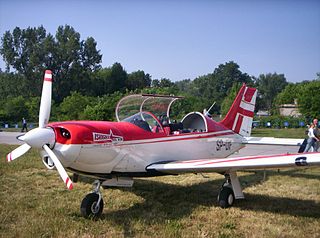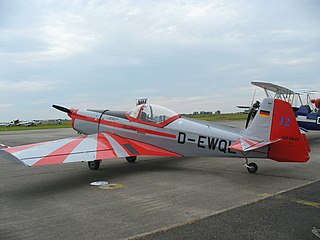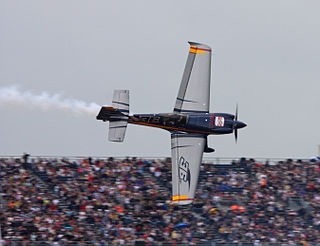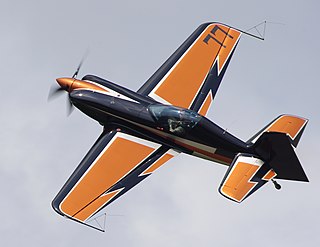
The Sukhoi Su-26 is a single-seater aerobatic aircraft from the former Soviet Union, powered by a single radial reciprocating engine. The Su-26 has mid-mounted straight wings and fixed landing gear, the main gear mounted on a solid titanium arc.

The Extra Flugzeugbau EA300 is a two-seat aerobatic monoplane capable of Unlimited category competition. It was designed in 1987 by Walter Extra, a German aerobatic pilot, and built by Extra Flugzeugbau.

The CAP Aviation CAP-23x family is a family of aircraft designed for competition aerobatics. The CAP 230 airframe was a direct development of the CAP 21 competition single seater strengthened to cope with a 300 hp (220 kW) 6-cylinder Lycoming AEIO-540 engine instead of the 200 hp (150 kW) original 4-cylinder Lycoming AEIO-360.

The Yakovlev Yak-18T is a four- or five-seat fully aerobatic utility aircraft developed by Yakovlev. Introduced to train Aeroflot pilots, it has gained some popularity as a sportplane both inside and outside the former USSR. It is powered by a 268-298 kW (360-400 hp) Vedeneyev M14P radial engine, and is designed for stresses of +6.48/-3.24 g.

The Zlin Z-50 is an aerobatic sports airplane built by the Czechoslovakian company Zlin Aircraft.

The Sukhoi Su-29 is a Russian two-seat aerobatic aircraft with a 268 kW (360 hp) radial engine. It was designed based on the Su-26 and inherited most of the design and technical features of its predecessor. Due to wide use of composite materials, which make up as much as 60% of the Su-29's aircraft structure, the empty weight is increased by only 50 kg (110 lb) over the single-seat Su-26's empty weight.

PZL M26 Iskierka or M26 Airwolf is a Polish trainer and aerobatic aircraft, designed at WSK PZL-Mielec.

The Mudry CAP 10 is a two-seat training aerobatic aircraft first built in 1970 and still in production in 2007. The plane was developed from the Piel Super Emeraude and was born as the CP100. The name changed to CAP 10, CAP for 'Constructions Aéronautiques Parisiennes'. The CAP 10 was manufactured by Mudry in Bernay, France, bought by CAP Industries which then became Apex Aircraft. Following the bankruptcy of Apex in 2008, rights to produce spares were awarded to Dyn'Aviation. After the bankruptcy of DynAero in 2012, manufacture of spares was taken over by CEAPR in Darois.

The Zlin Z-526 Akrobat is a Czech sports plane used in aerobatics.

The AS/SA 202 Bravo is a two to three-seat civil light aircraft jointly designed and manufactured by the Swiss company Flug- und Fahrzeugwerke Altenrhein (FFA) and the Italian company Savoia-Marchetti. The aircraft was designated the AS 202 in Switzerland, and the SA 202 in Italy.

The MXS is a single-seat aerobatic aircraft made of carbon fiber and built by MX Aircraft Company, a manufacturer located at Jandakot Airport in Perth, Western Australia. The MXS-R is a race variant flown by several pilots in the Red Bull Air Race World Championship. The planes are all-composite in construction, piston-powered, low-wing monoplanes. They are produced both in kit form for amateur construction, and completed ready to fly at the factory.
The Peña Bilouis is a French aerobatic amateur-built aircraft that was designed by the competitive aerobatic pilot Louis Peña of Dax, Landes and made available in the form of plans for amateur construction.

The XtremeAir Sbach 300 is a German aerobatic aircraft, designed by Philippe Steinbach and produced by XtremeAir, of Cochstedt. The aircraft is supplied as a complete ready-to-fly-aircraft.
The Stephens Akro is a single engine monoplane designed in the United States for aerobatic competitions. It first flew in 1967 and proved very successful, leading to several developments of which one won seven US Championships and one World Championship between 1975 and 1982. The Extra EA-230 and Extra EA-300 were also Akro developments with over two hundred built.
The Merkel Mark II is an American homebuilt aerobatic biplane that was designed by Edwin Merkel and produced by the Merkel Airplane Company of Wichita, Kansas in the form of plans for amateur construction.

The Speedtwin E2E Comet 1, originally named the Phillips ST1 Speedtwin, is a two-seat, twin engined aircraft designed in the UK to be capable of aerobatics and the only civil twin certified for intentional spinning. After a long development time, just two have been built.

The Rihn DR-107 One Design is an American aerobatic homebuilt aircraft that was designed by Dan Rihn and first flown in 1993. The aircraft is supplied by Aircraft Spruce & Specialty of Corona, California in the form of plans and a materials kit for amateur construction.
The Rihn DR-109 is an American aerobatic homebuilt aircraft that was designed by Dan Rihn. The aircraft was supplied by Jim Kimball Enterprises of Zellwood, Florida and more recently by Ashcraft Aero Works of Aurora, Illinois in the form of plans. It was designed for competition aerobatics as well as a trainer for the Rihn DR-107 One Design.

The Hatz Classic is an American homebuilt biplane, designed by Billy Dawson and produced by the Makelan Corporation of New Braunfels, Texas. The aircraft is supplied as a kit or, alternatively, in the form of plans for amateur construction.
The Starfire Firebolt, sometimes called the Starfire Firebolt Convertible, due to its removable canopy, is an American homebuilt aerobatic biplane that was designed by G. H. "Mac" McKenzie and produced by Starfire Aviation of Tempe, Arizona. When it was available the aircraft was supplied in the form of plans for amateur construction, with some pre-fabricated parts available.
















